On November 1, 2021, Dmitry Medvedev, deputy chairman of Russia’s Security Council, published an essay outlining six lessons from the COVID-19 pandemic. “COVID-19 has seriously accelerated the fourth industrial revolution. Since March 2020, there has been an explosion in the quantity and quality of a variety of online services, whether it be grocery delivery, access to government services, virtual cultural events, bank payments, or distance learning,” Russia’s former president and prime minister wrote. The main problem now facing the world, per Medvedev, was how to avoid a “digital divide” that would deprive people of “vital opportunities.”
Medvedev also argued that COVID-19 triggered a “global crisis of confidence” that could be remedied by “giving the World Health Organization the authority to make significant mobilization decisions in the interests of the entire world community in an emergency situation.”
Another important lesson from the pandemic was making vaccines accessible, and when deemed necessary, compulsory. Extolling the safety and efficacy of COVID-19 shots, the Russian statesman blamed “vaccine nationalism” for complicating efforts to inject the global population in a timely and cost-efficient manner.
Medvedev’s essay provided a remarkably honest overview of Moscow’s trajectory from the start of the pandemic until the end of 2021; that it resembled a boilerplate press release from the World Economic Forum was, to put it mildly, somewhat concerning.
But are Medvedev’s “six lessons” still applicable to Russia today, four months after Moscow launched its special military operation in Ukraine?
Sanctions in response to the conflict in Ukraine forced the World Economic Forum to cut all formal ties with Russian businesses and government institutions: the typical gaggle of Russian oligarchs were disinvited to Davos; Vladimir Putin’s profile was purged from the WEF’s website; Russia’s Center for the Fourth Industrial Revolution – founded in partnership with the WEF in October 2021 – announced in April that it had suspended its operations.
For Russia, divorce with the Davos-devout West represents a rare but narrow window of opportunity to reflect, reimagine, and, by all indications, reset.
But is Moscow taking steps to halt or reverse the Great Reset agenda that has swept the globe following the outbreak of COVID-19? Although no longer rubber stamped by Schwab, Russia’s technocratic revisioning of the social contract between government and citizen continues without any significant interruptions. From CBDCs to experimental genetic “vaccines,” Moscow is still marching to the same tune being played in Davos.
Rebuild everything
“The Fourth Industrial Revolution is a new chapter in human development, driven by the increasing availability and interaction of a set of extraordinary technologies, building on three previous technological revolutions … The world’s most innovative companies, governments and civil society organizations are combining new technologies in new products, services and processes that are reshaping existing ways of delivering value.”
– Klaus Schwab, Shaping the Future of the Fourth Industrial Revolution (2018)
On June 2, 2022, Russia’s leading businessmen and top government officials gathered for the Forum for Solving Social Problems. Launched in 2020 as part of President Vladimir Putin’s National Social Initiative (NSI), the conference’s mission of improving social services had taken on new urgency as Russia charted a new course in the wake of Western sanctions and deteriorating geopolitical conditions.
Attendees included Maxim Oreshkin, Assistant to the President of the Russian Federation; Dmitry Peskov, Kremlin spokesman and Special Representative of the President of the Russian Federation for Digital and Technological Development; Alexey Repik, founder of Russian pharmaceutical firm R-Pharm; and Herman Gref, CEO of Sberbank, Russia’s largest bank.
Speaking during the forum’s plenary session, billed as “New Time – New Challenges: People in the Spotlight,” Gref argued that technology needed to be harnessed to make Russian businesses and institutions more “customer-centric”:
“To become a customer-centric company, you need to rebuild everything: internal processes and technologies, because without technology it is impossible for a state, a social organization, or a commercial company to be customer-centric. Technology is the key to this world. Is it possible to move the social sphere in this direction? It is not only possible, but necessary.”
With Russia at a socioeconomic crossroads, the head of Sberbank called for “a complete redesign of processes” in order to remold “the client path.”
But what lies behind Gref’s impenetrable corporate word salad? What kind of “client path” does he have in mind for Russians? To answer these questions, it is first necessary to briefly review the life story of this “visionary” banker.
Herman Gref (Hermann Gräf in his ancestral tongue) was born on February 8, 1964 to German parents who were deported to the Kazakh SSR during World War II. He began working in the St. Petersburg government after finishing law school in 1990 and, by the end of the decade, was on the board of directors of several high profile companies, including state-owned airline Aeroflot and energy giant Gazprom. Gref then followed Vladimir Putin to Moscow, where he was appointed Minister of Economic Development and Trade in 2000.
Seven years later, he was handed the reins of government majority-owned Sberbank.
Perched atop Russia’s largest and most influential bank – and in control of nearly one third of all assets in the country’s banking sector – Gref’s international stature snowballed. In 2009, he became a member of the World Economic Forum’s International Business Council and two years later he was elected to the WEF Board of Trustees. (His profile, in contrast to that of Vladimir Putin, is still visible on the WEF’s website.)
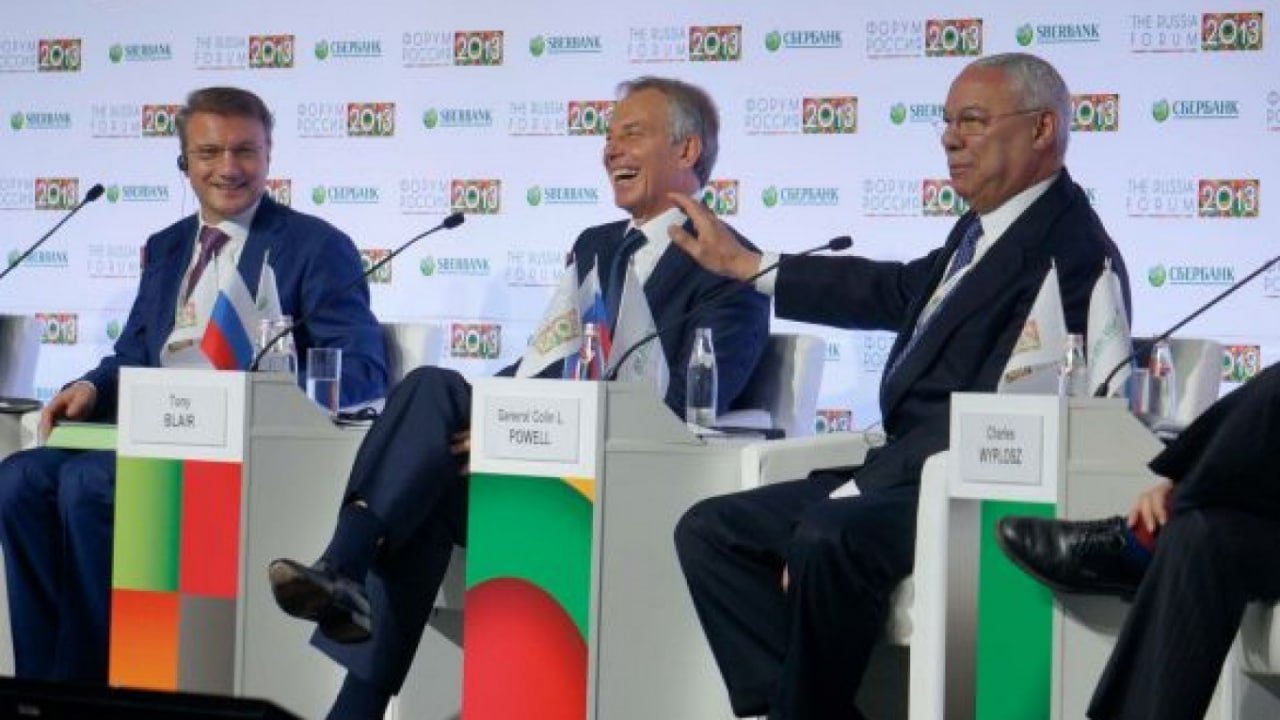
In 2012, the Sberbank CEO moderated a panel discussion at the St. Petersburg International Economic Forum called “Way Out from the Management Dead-End: Wisdom of the Crowd or the Authoritarian Genius?”
The panelists showed a certain squeamishness for “authoritarian” managerial practices, prompting Gref to liven up the conversation.
“You are saying terrible things,” the Sberbank CEO playfully scolded them. “You are proposing an actual transfer of power into the hands of the population… If each person can participate directly in management, then what are we managing?”
Citing Confucius and Kabbalah mysticism, he reminded his audience of the millennia-old tradition of shielding the truth from the easily excitable masses.
“People don’t want to be manipulated when they have knowledge. What does it mean to remove the veil from the eyes of millions of people and make them self-sufficient? How do you manage them? Any mass management implies an element of manipulation,” Gref concluded.
His comments were treated as scandalous by the Russian press, but the banker insisted his remarks were only meant to stimulate discussion, telling one interviewer that he “laughed heartily” when he learned so many people had taken offense.
The incident was soon forgotten, and a year later, in 2013, Gref was made a member of the international board of JP Morgan Chase, replacing Anatoly Chubais – the architect of post-Soviet privatization in Russia.
That same year, the Sberbank CEO penned the forward to Scenarios for the Russian Federation, a report published by the World Economic Forum. According to Gref, the document attempted to take “a structural view of the key uncertainties, risks, challenges and development opportunities for the Russian Federation in the near future.” Klaus Schwab, founder and chairman of the WEF, expressed hope that the report would “lay the groundwork for more productive conversations between all stakeholders in the Russian economy.”
The report was just one of many fruitful collaborations between Schwab and Gref. In 2016, the CEO of Sberbank had the honor of authoring the preface to the Russian-language edition of Schwab’s The Fourth Industrial Revolution:
“The fourth industrial revolution will have a dramatic impact on the entire structure of the world economy, and if we want to be among its leaders, we must understand what direction technological development will take in the coming years, and what breakthrough innovations await us in the future.
Klaus Schwab, who wrote the book The Fourth Industrial Revolution, is the President of the World Economic Forum in Davos and therefore is in a unique position to summarize the experience and views of the world’s leading experts in the field of economics and technology …”
To Gref’s credit, he practiced what he preached. In a December 2017 article marking his tenth year as head of Sberbank, Vedomosti (Russia’s equivalent of the Wall Street Journal) highlighted Gref’s obsession with technological development – to the point where the bank’s upper management struggled to keep up with him.
“I have a typical perfectionist profile. Perfectionism is a mental illness, and you try to do everything as flawlessly as possible all the time, even though it’s not optimal, and it’s not necessary,” Gref was quoted as admitting.
It would take several more years of hard work – and the arrival of COVID-19 – before the Sberbank CEO would be able to realize his vision of the ideal “client path.” As Schwab prophetically declared in the early months of 2020, “the pandemic represents a rare but narrow window of opportunity to reflect, reimagine, and reset our world.”
Gref seized on this opportunity to “reset.” On Sep 24, 2020, Sberbank announced it was no longer a mere financial institution, but instead “a whole universe of services for human life and businesses.” The bank declared it would henceforth be known as Sber, “a new brand for our new role in human lives.”

The Sber umbrella would cover all aspects of life. Russians would now have access to services such as SberMarket, SberHealth, SberGames, SberAuto, SberFood, SberSound, and the key to unlocking them all, SberID.
A feature published by TASS described the Sber future that awaited Russians:
“Zhenya goes to work using Citydrive carsharing, orders lunch using Delivery Club, calls a taxi at 17:59, reads Gazeta.ru on the way home, and in the evening watches a movie on Okko [a Russian streaming service] and for dinner has a meal he cooked from groceries delivered from SberMarket. He does all this … through a single SberID login system.
This is what the digital ecosystem looks like, the latest stage in Sber’s development … In the future, it is this ecosystem that will be the basis for integrating the interests of people, business, and the state as a whole. […]
For the ordinary user, SberID provides access to a large number of non-banking services in this ecosystem that simplify shopping, health care, entertainment, job search – that make life more comfortable in general.”
Participation in Sberbank’s digital “universe” is not compulsory – at least not yet.
However, Gref already exerts inescapable influence over Russia. Quietly and methodically, Russia’s leading disciple of the fourth industrial revolution has introduced a range of “services” that are practically impossible to opt out of. There is only one “client path”, and Gref has designed it to be non-optional sooner rather than later.
The Sberbank CEO has created a “parallel world in which he is the president,” Tsargrad, a leading conservative broadcaster in Russia, complained in January 2021.
Digital currencies
“By the 2030s, versions of distributed ledger technologies or ‘blockchains’ may well change everything from online financial transactions to the way we vote and how we tell where goods are produced.”
– Klaus Schwab, Shaping the Future of the Fourth Industrial Revolution (2018)
The introduction of the digital ruble is on track and ahead of schedule, according to First Deputy Chairman of the Bank of Russia Olga Skorobogatova, speaking at the 2022 St. Petersburg International Economic Forum.
It will be possible to start testing Russia’s Central Bank Digital Currency (CBDC) in 2023, a year earlier than planned, she told the conference on June 16.
Russia should aim to be among the world’s top three innovators in the payment and financial sectors, Skorobogatova said, adding that the Bank of Russia was already working on the implementation of smart contracts for its centralized digital currency.
Russia’s central bank unveiled its plans to develop a digital ruble in October 2020, and a prototype was completed a year later. On February 15, 2022, the Bank of Russia announced that two of the commercial banks participating in the pilot program had successfully carried out financial transactions using the new platform.
“Clients not only opened digital wallets on the digital ruble platform through a mobile application, but also exchanged non-cash rubles from their accounts for digital ones, and then transferred digital rubles to one another,” the Bank of Russia reported.
Proponents of Russia’s CBDC claim it will “reduce costs and create opportunities for the development of innovative products and services.”
The introduction of the centralized digital currency also comes with disadvantages. In December 2021, Vedomosti reported that the digital ruble would allow Sberbank and other Russian financial institutions to “track the spending of funds by citizens.”
Blockchain consultant and cryptocurrency researcher Denis Smirnov told the paper that for ordinary Russians, “the introduction of the digital ruble is the materialization of the most terrible scenarios described by science fiction writers in dystopias.”
“According to the expert [Smirnov], with the advent of the digital ruble, absolute transparency will reign in the field of personal finance, which means that the human right to privacy will be under attack,” Vedomosti wrote.
Speaking at Cyber Polygon 2021 – which was co-hosted that year by the World Economic Forum and Sberbank – Bank of Russia Deputy Governor Alexey Zabotkin gushed about the digital ruble’s potential.
Russia’s CBDC “will permit better traceability of payments and money flow, and also explore the possibility of setting conditions on permitted terms of use of a given unit of currency,” said Zabotkin.
For example, parents could give their children digital rubles that have been programmed to block the purchase of junk food, the central bank official explained. “That would be a useful functionality for a customer, and of course you can come up with hundreds of other similar use cases,” Zabotkin also noted.
Russians wary of the Bank of Russia’s centralized, programmable currency can turn to the “private” sector for an alternative. In March 2022, Russia’s central bank issued Sberbank a license to issue and exchange digital financial assets. Using its own platform, Sberbank is expected to make its first digital asset transaction by mid-July, Deputy Chairman of the Board of Sberbank Anatoly Popov told TASS on June 15. The bank’s centralized blockchain will allow companies to issue their own digital assets and make transactions using digital currencies deployed on the platform.
Sberbank has been tight-lipped about the first digital asset it will deploy. However, at the end of 2020, Gref revealed that his bank was teaming up with JP Morgan to create “Sbercoin.” The cryptocurrency – reportedly a stablecoin – has yet to launch and, due to sanctions, it’s unclear whether JP Morgan is still participating in the project.
The Sberbank CEO has been a longtime cheerleader for digital currencies. A report from December 2013 claimed Gref – then a newly minted member of JP Morgan Chase’s international board – was exploring Sberbank’s entry into the crypto market. In the same month, JP Morgan Chase announced it was building its own cryptocurrency using technology that the American bank first patented in 1999.
Avoiding the digital ruble won’t protect Russians from unprecedented surveillance by the Bank of Russia, however. Starting in January 2022, the Central Bank began requiring Russia’s commercial banks to disclose information about all P2P (people to people) transactions, including personal data of senders and recipients of funds.
Safe (and smart) cities
“As well as the rise of secure distributed ledgers such as the blockchain, innovations in IoT architecture encourage opportunities to find this balance in new ways. For example, Sensity Systems (a Verizon company) worked with Genetec to design smart city security systems to manage both security and privacy concerns.”
– Klaus Schwab, Shaping the Future of the Fourth Industrial Revolution (2018)
On June 20, 2022, Russia’s Kommersant newspaper reported that the Ministry of Emergency Situations (EMERCOM) was planning to deploy its Safe City system to regions bordering Ukraine – Krasnodar Territory, Crimea and Sevastopol, and Voronezh Belgorod Oblasts. A source told the paper that implementation of the high-tech surveillance network had become an “extremely urgent task” due to heightened security threats stemming from the special operation in Ukraine. (Kursk, located in a border region of the same name, became a “safe city” in March 2022.)
Created in December 2014, Russia’s Safe City program uses “organizational, informational, analytical, predictive, and other methodological, technical, and technological solutions to ensure the safety and sustainable development of cities.”
As EMERCOM explains on its website:
“Safe City is best known for its law enforcement bloc. Surveillance cameras that record violations of public order and traffic rules are installed and operate in almost all participating areas. However, the purpose of the project is not so much to respond to incidents, but to prevent them: to determine that trouble is looming before it occurs.”
The federal program has been introduced across the country, including in Russia’s most far-flung regions. In Yamal, northwestern Siberia, 1000 video surveillance cameras will be installed this year as part of the Safe City project. Tatarstan’s network of 60,000 Safe City surveillance cameras recently received a software upgrade that makes it possible to identify stray dogs, according to a local media report from April 2022. Murmansk announced in the same month that it will put 1400 cameras into operation as part of its transition into a “safe city.” Regional authorities said the surveillance system will include software capable of recognizing faces, suspicious objects, and trespassers.
A report from June 2021 found that Russia ranked second worldwide in terms of growth in the number of surveillance cameras. Chinese manufacturers have been the biggest beneficiaries of Russia’s increasing demand for surveillance equipment, according to Kommersant.
Moscow has undergone the most radical transformation among Russia’s “safe cities.” More than 213,000 CCTV cameras watch over the Russian capital – and even privately operated security systems are now connected to the city’s centralized surveillance grid.
In May 2022, Moscow Mayor Sergey Sobyanin ordered nightclubs to link their cameras to a unified monitoring center featuring sophisticated facial recognition software. Similar instructions were issued in autumn 2021, when the mayor’s office demanded that shopping malls connect their cameras to their centralized system so that city authorities could monitor compliance with mask rules. Around the same time, Moscow launched “Face Pay,” a facial recognition payment system that has been installed in more than 240 metro stations across the capital. In September 2021, the Moscow Department of Education and Science unveiled plans to introduce facial recognition systems in city schools. Despite protests from parents, these new biometric security systems began to appear in schools in January 2022.
Like Gref, Sobyanin saw the COVID-19 pandemic as an opportunity to flex his managerial capabilities. In February 2020, the mayor announced that compliance with quarantine measures in Moscow would be monitored using the city’s facial recognition system – with help from Sberbank.
On February 27, 2020, Gref revealed his bank was working on facial recognition systems specifically tailored to help Russia cope with COVID-19.
“We are also developing masked face recognition technology. We tried to understand what our colleagues in China are doing. We did the same. We tried to look for our own solutions,” the Sberbank CEO said.
In May 2020, with most of Russia still under lockdown, Gref outlined plans to allow schools and universities to reopen: a device developed by Sberbank would use facial recognition and temperature measurement to identify potential carriers of the virus.
Sberbank began developing biometric identification and payment systems long before the COVID-19 pandemic. In 2015, the bank launched Ladoshki (“Little Palms”), a cashless payment system for school meals, where instead of cards and smartphones, biometric data was used as an identifier.
“To pay for lunch, the student puts his hand to the scanner on a special machine, selects a dish from the menu, and the money is automatically debited from the account attached to the biometrics,” explained an article from October 2020.
The transition to biometric identification is not limited to Moscow schoolchildren. Regions were already testing biometric IDs in 2019, and the Ministry of Education wants facial recognition systems in all Russian schools by 2024.
In autumn 2021, Samara opened a new school where “the safety and comfort of children come first”:
“The child holds a magnetic key up to the door to enter the school grounds. Then in the hall he passes through a turnstile, which identifies him. That same Face ID system measures the temperature of each visitor, and only allows them to enter if their temperature is normal. If the temperature of the child is elevated, the parents will be called and asked to take them home. A mechanism is being developed that will allow parents to monitor their children during the day and observe their movements.”
Sooner or later, Russians of all ages will have to acquiesce to some form of biometric identification. In April 2021, Sberbank partnered with state-owned digital services provider Rostelecom to develop a Unified Biometric System. The database will eventually be merged with state institutions, requiring Russians to use a biometric ID to access government services.
The integration of biometrics into daily life is part of the Russian government’s vision for the creation of “smart cities,” a national initiative that predates – but has been greatly accelerated by – the COVID-19 pandemic.
Spearheaded by the Ministry of Construction and Housing, Russia’s Smart City program aims to create “an effective urban management system, creating safe and comfortable living conditions for citizens.”
Sobyanin’s “Smart City – 2030” project for Moscow provides an extreme example of what this initiative hopes to accomplish. The ambitious reimagining of the Russian capital is already being carried out by the city’s Department of Information Technologies.
Among other perks, Moscow residents will be issued “genetic passports” that can be used to administer gene therapies. “Wearable and implanted medical digital devices” will collect information about an individual’s lifestyle and calculate payments to health insurance companies.
By the end of the decade, Russia’s capital will harness “digital technologies” to ensure “sustainable growth in the quality of life of Muscovites,” according to the project’s official website.
Genetic “Vaccines“
“Engineering different types of smart cell factories could also empower us to cope with emerging infectious diseases, for example, by the accelerated generation of vaccines and therapeutic antibodies.”
– Klaus Schwab, Shaping the Future of the Fourth Industrial Revolution (2018)
In April 2021, Russian President Vladimir Putin instructed his government to take drastic measures to ensure the country was prepared for another coronavirus-like health crisis.
“In the event of an infection as dangerous as the coronavirus or perhaps more, God forbid, Russia must be ready within four days – precisely within four days – to develop its own test systems, and in the shortest possible time to create an effective domestic vaccine, to start its mass production,” Putin said while addressing Russia’s legislature.
The lightning-fast development of tests and vaccines will be part of a “powerful and reliable shield in the field of sanitary and biological safety.” Sanitary Shield, a network of laboratories and border checkpoints tasked with safeguarding Russia’s biosecurity, is slated to be fully operational by 2030.
Although years away from completion, the rapid-response system sprang into action after the emergence of monkeypox in May 2022. In less than three weeks, Rospotrebnadzor, Russia’s agency for “human welfare,” unveiled a PCR test to detect the new disease. The test was created “to assist the World Health Organization in developing advanced rapid diagnostic methods,” according to Rospotrebnadzor’s Vector Institute.
By the end of May, Vector had also registered a smallpox vaccine, “a genetic composition that forms stable immunity and at the same time has a high safety profile.”
It’s unclear whether the drug was created in response to the new epidemiological threat or if it was developed beforehand in anticipation of such a scenario. Under Sanitary Shield, the rapid development of new vaccines will use Sputnik V’s genetic, adenovirus-based platform as a template.
“Today, science and engineering has reached a level that allows us to build [vaccines] like a designer, using biological, mathematical, and other methods,” Deputy Prime Minister Tatyana Golikova explained in September 2021.
To understand the implications of this vaccine deployment strategy, it’s important to understand how Russia’s flagship COVID-19 shot came into existence.
Developed by the Health Ministry’s Gamaleya Center, Sputnik V is a two-dose vaccine that uses two different adenovirus vectors (Ad26 and Ad5) to transport “genetic material” to cells. The platform can be traced back to a 2012 patent application, listed on Sputnik V’s official website, which describes Gamaleya’s Ad5-based flu shot as a “genetic vaccine.” The influenza vaccine, GamFluVac, was never introduced into the international market and according to reports has yet to receive approval in Russia.
Gamaleya redeployed the same Ad5 platform to create a vaccine during the 2013-2016 Ebola epidemic in West Africa, but it was never submitted to the WHO for certification. A later attempt by Gamaleya to create a genetic vaccine to fight Middle East Respiratory Syndrome (MERS) was shelved without a finished product.
Despite these repeated failures, Gamaleya launched Sputnik V into orbit in record time.
Promoted as the “world’s first registered COVID-19 vaccine,” Sputnik V received emergency use authorization from Russia’s Health Ministry on August 11, 2020, after completing combined Phase I-II trials involving 76 volunteers – a process that lasted less than two months.
The speedy creation and rollout of the drug can be attributed to Gamaleya’s collaboration with Sberbank and the Russian Direct Investment Fund (RDIF), Russia’s sovereign wealth fund and the vaccine’s main financier.
Although vaccine research and production is seemingly outside the purview of a bank, Sberbank played a critical role in Sputnik V’s early development.
“We have good project management technologies and we were asked to quickly and efficiently facilitate the entire process, helping the Ministry of Health and, of course, the Gamaleya Center,” Gref revealed in an interview with RBK in April 2021. The Sberbank CEO explained that his bank was “included in the work of creating a vaccine” and helped “ensure the transfer of technology to production sites.”
In May 2020, Sberbank registered a subsidiary, Immunotechnologies LLC, which was specifically created as a “project office to support the production of a vaccine against the new coronavirus.”
A government order issued by Prime Minister Mikhail Mishustin in December 2020 designated Sberbank subsidiary Immunotechnologies as the sole supplier of Sputnik V to Russia’s regions. It shipped the first 9 million doses of the vaccine before transferring supply and delivery logistics to state conglomerate Rostec in March 2021.
Gref’s bank practically adopted Sputnik V as one of its own products. Sberbank employees were urged in May 2020 to participate in the drug’s earliest phases of testing, and the company later launched a marketing campaign aimed at convincing Russians that “normal life” would not return without mass vaccination.
The bank even released a promotional video – complete with a wistful soundtrack and dramatic one-liners – called “SberVaccination: IT’S TIME!”
The Sberbank CEO led by example. In December 2020, Gref revealed he was among the first to be injected with Sputnik V. He later claimed the vaccine likely “saved his life” during a business trip.
The head of Russia’s largest bank claimed he received the barely tested vaccine sometime in April 2020, meaning he was likely part of “informal trials” in which Gamaleya Center scientists injected themselves and family members with the experimental drug. Formal Phase I testing began on June 18.
While Sber got the project off the ground, RDIF ensured Sputnik V’s success in international markets.
RDIF CEO Kirill Dmitriev, a World Economic Forum Young Global Leader, Class of 2009, reportedly came up with the name “Sputnik V” (formally known as Gam-COVID-Vac).
Dmitriev’s talent was spotted at an early age. The Soros Foundation awarded him a scholarship to study in the United States, where he attended Stanford University and Harvard Business School. After graduation, he worked for Goldman Sachs and McKinsey & Company before taking the reins at RDIF in 2011.
In June 2020, RDIF announced a joint venture with R-Pharm, one of Russia’s largest pharmaceutical firms, to manufacture and distribute what later became known as Sputnik V. The pair already had a close relationship: In 2018, RDIF acquired an estimated 10% stake in R-Pharm.
RDIF’s decision to partner with R-Pharm would prove to be a shrewd investment decision that gave Russia’s sovereign wealth fund access to markets that were closed to Sputnik V.
On July 17, 2020, AstraZeneca announced R-Pharm would become “one of the hubs for the production and supply of [its] vaccine to international markets.” Under the agreement, the British-Swedish pharmaceutical giant agreed to transfer its adenoviral vector to Russia. R-Pharm would then be tasked with “finishing” doses and shipping them abroad.
“AstraZeneca is confident that, together with R-Pharm, it will be able to supply millions of people with the vaccine in the most efficient way,” the company wrote in a statement.
Their partnership was strengthened and expanded in December 2020, when RDIF, AstraZeneca, the Gamaleya Center, and R-Pharm signed a memorandum of cooperation. Under the agreement, the partners launched joint trials in hopes of eventually developing a vaccine “cocktail.”
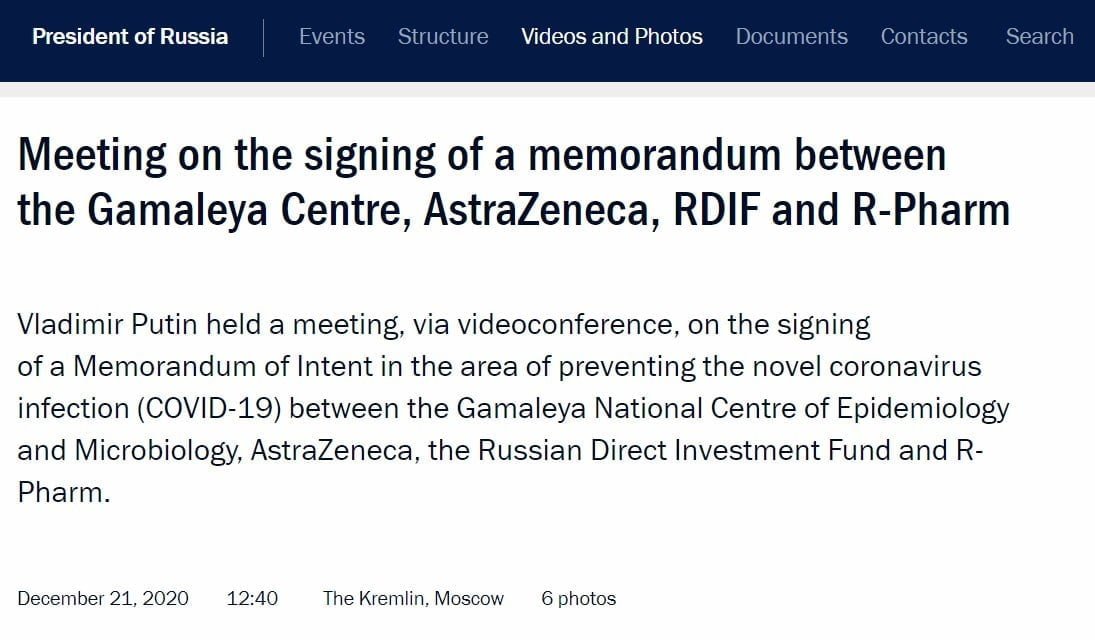
“Today we announce a clinical trial program to assess safety and immunogenicity of the combination of AZD1222, developed by AstraZeneca and Oxford University, and Sputnik V, developed by Russian Gamaleya Center… Both AZD1222 and Sputnik V are adenoviral vector vaccines that contain genetic material of SARS-CoV-2 virus spike protein,” AstraZeneca said in a December 11 press release.
While AstraZeneca’s shot has been repeatedly linked to blood clotting and other serious adverse reactions (most recently in May, when the Telegraph reported that the drug “may increase the risk of a serious neurological condition”), far less is known about Sputnik V’s safety profile.
Russia does not have a VAERS-like database that the public can use to report and view suspected post-vaccination complications. However, an abundance of evidence raises doubts about the Russian government’s claim that Sputnik V is “safe and effective.”
In September 2021, Dr. Vitaly Zverev, a professor of virology and member of the Russian Academy of Sciences, found a close correlation between the increase in vaccination and the increase in morbidity and mortality from COVID-19 in Russia.
“Nobody knows about the long-term consequences [of the vaccines]. Therefore, it is impossible as of now to vaccinate three times with the vector adenovirus vaccine that is actively used in Russia [Sputnik V],” Zverev concluded.
A separate analysis by Russia’s Krasnaya Vesna, which inspected Sputnik V’s safety record in countries that report adverse reactions, determined that “in terms of the frequency of expected mild and severe (requiring hospitalization) side effects, [Sputnik V] is comparable to foreign counterparts.”
Despite the clear red flags, Russia’s Health Ministry continues to stonewall calls for greater transparency. In January 2022, the ministry explained that it would be “impractical” to publish data on the number of deaths among those vaccinated, since “such information does not objectively reflect any relationship between deaths and vaccination and may cause a negative attitude towards vaccination.”
A few days later, a State Duma deputy who tried to obtain the most recent clinical trial data for Sputnik V was informed by the Health Ministry that such information was a “confidential” trade secret that belonged solely to the drug’s developer.
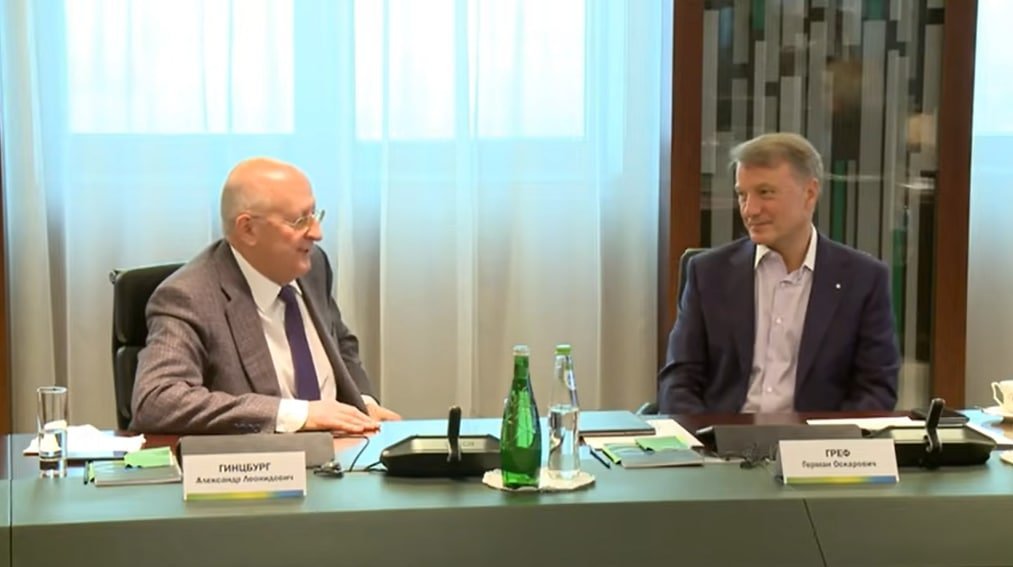
In the eyes of the Russian government, Sputnik V represents a resounding victory for next-generation genetic technologies.
“We have developed several such breakthroughs in parallel. This primarily concerns the Sputnik V vaccine, which uses genetic technologies and is already in use today,” the Russian Health Minister said in November 2021, adding that Russia was already creating new vaccines based on Sputnik V’s platform.
As for Sputnik V’s much-vaunted efficacy: On April 10, 2021, Alexander Gintsburg, the director of the Gamaleya Center, predicted that Russia’s flagship vaccine would provide lifelong immunity against COVID-19. Exactly one year later, on April 10, 2022, Gintsburg recommended that Russians get revaccinated every six months and even encouraged COVID-conscious citizens to receive two boosters at the same time.
Sustainable development
“We must develop overarching global governance principles while respecting nations’ different historical, economic, social and cultural systems, ethical norms and values. This will require finding common, broadly accepted values and building on existing governance, such as the Universal Declaration of Human Rights and the UN Sustainable Development Goals. […]
Besides consumer drivers and reputational hazards, government regulation will be crucial to making manufacturers responsible for the environmental impacts. Luckily, to meet our sustainability goals, other technologies of the Fourth Industrial Revolution provide innovative solutions in this governance space.”
– Klaus Schwab, Shaping the Future of the Fourth Industrial Revolution (2018)
On September 4, 2020, Sberbank participated in the first event of Russian Chapter, the Russian branch of the World Economic Forum’s Climate Governance Initiative (CGI).
“Environment and sustainable development issues — ESG (environmental, social, governance) — rank high on Sberbank’s list of strategy and corporate culture priorities,” the bank said in a press release. “Sberbank’s environmental policy covers all domains, from interactions with external customers and investors to the responsible behavior of every employee. Following the principles of sustainable development helps to reduce the negative environmental footprint.”
In December of the same year, Sberbank became a general partner to Russian Chapter, describing the move as an “an important step to achieve one of the ambitious goals outlined in Sberbank’s new strategy, which is to lead Russia’s sustainable development agenda.”
The newly created forum met on December 17, 2020 to discuss “how Sberbank is reshaping its strategy and incorporating sustainability into its business model” and “how the Central Bank of Russia works together with key international organizations to share best practices in climate risk management.”
The bank took its role as a trailblazer for ESG in Russia seriously. A year later, on December 1, 2021, Sberbank announced the formation of Russia’s National ESG Alliance.
Composed of 28 companies responsible for 10% of Russia’s GDP, the group was conceived as a “permanent platform for dialogue and engagement for all stakeholders.”
Founding members included oil giant Gazprom Neft and Sputnik V manufacturer R-Pharm.
According to Gref, the Alliance aimed to combine the efforts of leading companies to “drive the [ESG] agenda” in Russia:
“We realized that we had to work on shaping regulatory frameworks, standards, and implementation control procedures, forming a new legislation that will stimulate all market participants to comply with ESG standards, and promoting the interests of Russia and Russian companies internationally.”
On April 21, nearly two months after the start of Russia’s special operation in Ukraine, the Alliance convened a meeting in order to “update” its work plan for the year, “taking into account the specifics of the current political and economic situation.”
Among other goals, the group resolved to “replenish and strengthen national ESG infrastructure related to reporting, standards, ratings, certification”; “contribute to the improvement of national ESG regulation, including the climate and carbon agenda”; and “[promote] educational activities [in Russia] on the subject of sustainable development, directed at a wide target audience.”
“We see that, despite the difficulties, companies remain committed to the ESG ideology and are not abandoning their earlier commitments to environmental, climate, and social initiatives,” the group’s CEO, Andrey Sharonov, said, summarizing the meeting’s outcome.
These weren’t empty words. ESG was a top agenda item at the 2022 St. Petersburg International Economic Forum (SPIEF). On June 16, conference-goers discussed “The Importance of the Climate Agenda in Key Eurasian Economies”:
“A joint climate agenda should be one of the unifying projects in such a diverse region as Eurasia. Today, economic cooperation needs to be developed as part of the climate agenda, partly in an effort to achieve the goals of the Paris Agreement and the UN Sustainable Development Goals …”
Panelists included Russia’s First Deputy Minister of Economic Development Ilya Torosov, Sberbank’s Senior Vice President for ESG Tatiana Zavyalova, and National ESG Alliance CEO Andrey Sharanov.
What does “economic cooperation” as part of “the climate agenda” mean for one of the world’s largest energy exporters?
At the end of January, Vedomosti published an in-depth report about how the National ESG Alliance might accelerate Russia’s integration into the European Union’s carbon credit system.
Under the bloc’s Carbon Border Adjustment Mechanism (CBAM), starting from 2026, importers of cement, iron and steel, aluminum, fertilizers, and electricity will be required to purchase carbon certificates corresponding to the “carbon price” that would have been paid to produce the goods inside the EU. As Vedomosti pointed out, this new scheme will require Russia to develop its own carbon regulation and emissions trading system in order to stay competitive as a raw materials exporter.
The growing economic rift between Moscow and Brussels would suggest that compliance with EU regulations is no longer the Alliance’s top priority. However, this does not mean Russia has dropped ESG. Instead, the group has called for “systematic dialogue with cross-country associations in ‘new’ markets, including the BRICS countries, the Eurasian Economic Union, and part of the Asia-Pacific region, as well as establishing interaction with the ESG expert communities in these regions.”
The client path: Which way, Russia?
While Moscow may be parting ways with its “Western partners” in search of more reliable markets, it is necessary to ask what the continuation of this economic and political pivot – which began more than a decade ago – means in practical terms.
On February 4, Russia and China released a joint statement declaring a “new era” for international relations and global sustainable development:
“In order to accelerate the implementation of the UN 2030 Agenda for Sustainable Development, the sides call on the international community to take practical steps in key areas of cooperation such as poverty reduction, food security, vaccines and epidemics control, financing for development, climate change, sustainable development, including green development, industrialization, digital economy, and infrastructure connectivity.”
Are Moscow and Beijing resisting the Davos-endorsed path, or are they building a parallel system using a similar blueprint? Are these two “sustainable development” partners opposed to world governance or do they instead want to be equal “stakeholders” in existing and future global superstructures?
The argument that Moscow is begrudgingly mirroring the West as part of a biothreat-fueled technocratic arms race raises a whole other set of questions. Can Russia responsibly harness technologies that have been abused and misused by western governments? If a PCR test is not fit for purpose in the West, can the same test protect Russia from biological threats as part of its Sanitary Shield program? Is the global adoption of CBDCs an attack on financial freedom in the United States, but a necessary measure to ensure Russia’s economic sovereignty?
These are the kinds of questions we should be asking ourselves as our increasingly chaotic world fragments into seemingly irreconcilable blocs.
Whether in the East or the West, will the “client path” be fundamentally different?
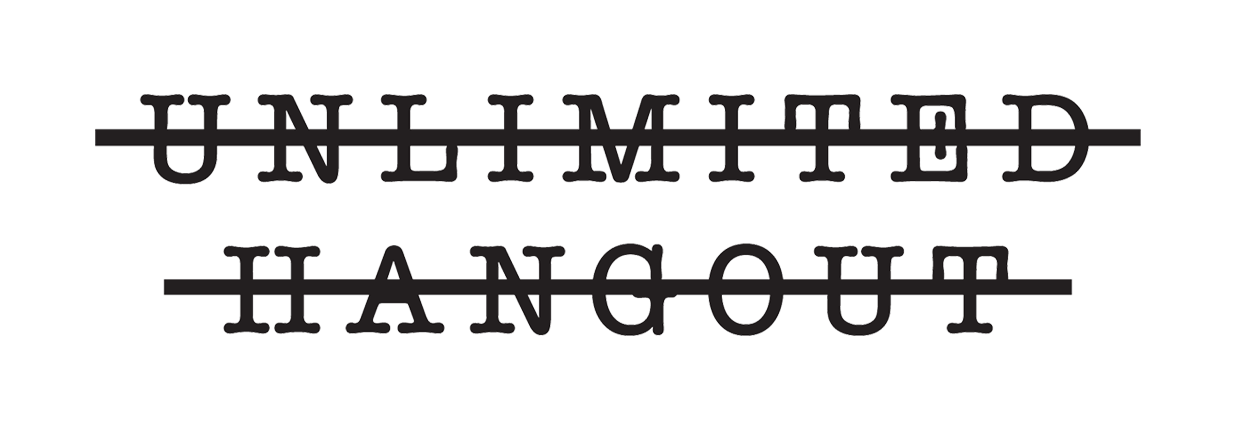
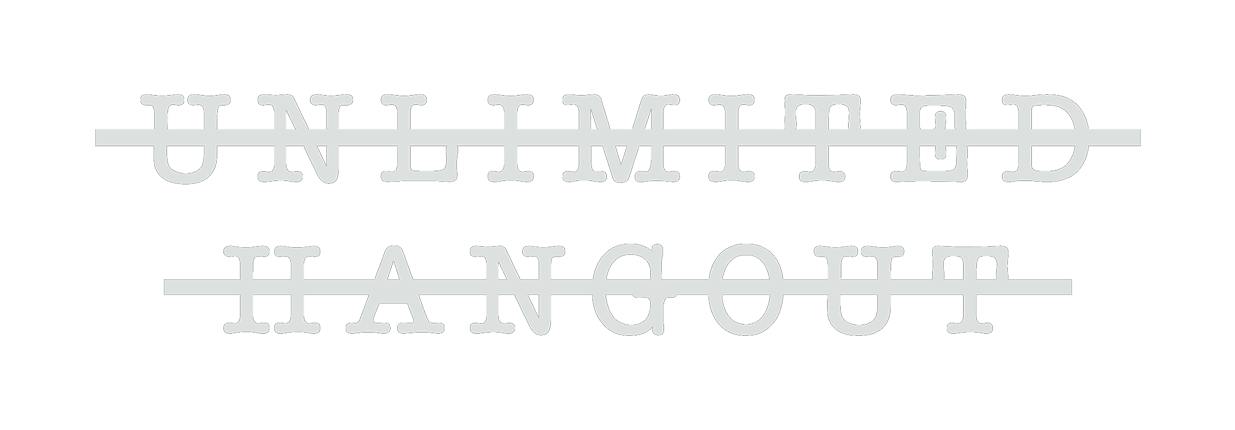




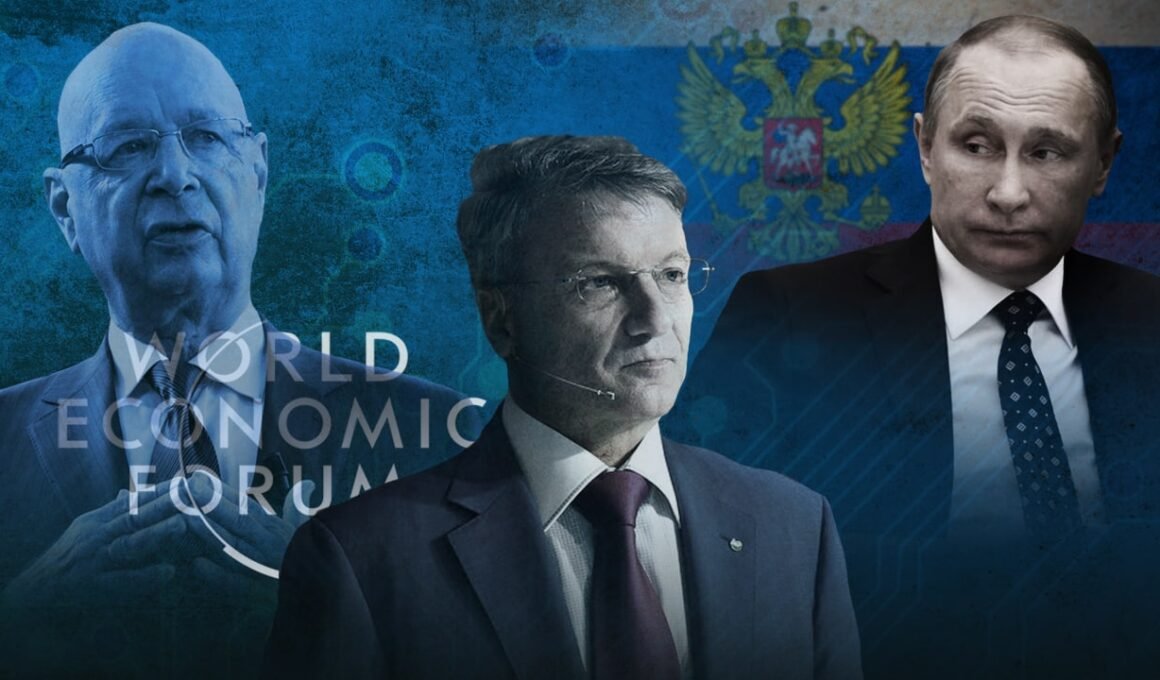




Wow, that is illuminating! Everybody wants to monopolize the digital ecosystem, not surprisingly.
It seems as if all the developed country leaders are sold on untested genetic technologies. I thought Russians were into natural stuff. That was disappointing. In the US, we are learning by dint of FOIA requested trials data that the mRNA vaccines produced more deaths in the treatment arms than in the placebo arms. They are poison.
I would love to read an article about Peter Garyaev and the status of his work in RU.
Welp, I’ve been telling everyone for four months that the Russian establishment is actively cooperating with the WEF, and that the mess in Ukraine is *designed* to be a mess – because a protracted conflict provides the greatest destruction of existing paradigms (energy, trade, industry, society, etc.) internationally, not just in Russia. Putin is the Khazarian Mafia’s point man in Russia, helping bring about the long-planned destruction of the West and transfer of geopolitical power eastwards. Face it: Putin is a bad guy, working with Western leaders to F up our once-proud civilisations.
I can’t argue with your statement…
… but the only time I remember having the illusion of “proud civilisation” was in the 70’s, when I was a teenager, totally oblivious of what was going on and was part of the herd.
Just a tought. 😉
Great job. Very thorough!
Thank you so much Riley for compiling this information, thus painting a very clear picture of this stark Reality that the entire world must now face.
Thank you very much for this information and round up of what’s happening now and in the past. It directly addressed many of my concerns around Russia’s involvement in the 4th Industrial Revolution etc. It seems that we have three levels of power – the top is actual energy that can be stored and deployed – around which the Oligarchs or Elites in-fight or collaborate and then finally ‘us’ who do what we can to achieve peace and physical agency.
This is one brilliant article, thanks! Saw it on the Unz Review thanks to one commenter. I have a few things to say.
1. There will always be uncontrollable areas of the planet, such as the Turks, Iranians and Egyptians of West Asia – at least, without a Hitlerian-esque solution (which wasn’t applied either in Iraq or Afghanistan).
2. Russia has clearly demonstrated its lack of sovereignty in the conduct of its sham of a war – that’s why most Russian nationalists view Putin as a Western puppet.
3. To determine the people’s character of a given government, I would look to a corollary statistic – namely, the growth of foreigner populations in the host nations. This way, both America and Russia are similar with their Mexicans and Caucasians respectively. Meanwhile, the population of Guangzhou Africans has dropped dramatically for China.
4. Likewise, both China and Juche Korea seem to weed out corrupted bureaucracy, while Russia and America allow it to fester.
Hmmm…. Try using yor usual services and resources on the Web without a Google account! It’s already too late.
Impressive work.
I also had the impression that Russia was more on the natural stuff, with their non-OGM promotion, and promoting/supporting new farmers.
I cannot disregard all the information in your article, still I am filled with that sentiment of suspicion about EVERYTHING. What we think we see is never what is. But that is probably one of THEIR goal, disorient everyone so there is little resistance to their objectives.
Thx to your brilliant research & analysis.
Great, very informative article. I am impressed by Mr. Waggaman’s indepth research, knowledge and eloquent writing.
Love the article, I had no idea about all this,
I like your clear and concise way of writing.
Excellent in depth writing, I guess still had some hope” Putin was on the right side of history and was truly working against the NWO, sadly it appears the elite’s favorite strategy, is always control both sides to assure the win. This leaves only us to fend for ourselves our freedom and life, no one else will do it for us.
The faster we come to terms with this bitter reality, the faster we’ll be organizing, and awakening more people to the truth.
Stay on God’s side, we can’t win an spiritual war, with just physical means.
Thanks for the excellent article, and superb writing.
Well said, Nacho.
Very interesting and thought-provoking article. Fauci must be envious of that Sputnik 5 vaccine info-mercial.
Is the Russian media gagged, that’s why its not reporting all the developments going unnoticed.
Any source to read Russian news besides RT, which appears a little open but still not reporting enough.
This article has obviously hit a sore spot with many in the alt right.
Harry Vox put out a video attempting to claim that Putin wasn’t in control and that the people around him were doing what he doesn’t want.
I posted a link to this article as a counter to his obviously misinformed perspective and was banned.
Amazing how truly good journalism makes the rats run.
Yes, Orwells 1984 again comes to mind. Russia are not a monolith centered around Putin as is commonly portrayed in the West. They are not necessarily the good guys or the saviors, either.
Instead, perhaps, we will end up with something like Oceania East Asia and Eurasia.
“As Winston well knew, it was only four years since Oceania was at war with EastAsia, and in alliance with Eurasia. …The past was alterable. The past had never been altered. Oceania was at war with EastAsia. Oceania has always been at war with EastAsia. Since the beginning of your life, since the beginning of the party, since the beginning of history, the war has continued without a break, always the same war….
Central propaganda hub of the Great Reset is the climate gas lie. Supporting this lie is support of the Great Reset.
There ARE toxic products of fossil fuel combustion that do incredible damage to our health and the health of other creatures; however, carbon isn’t one of them.
i’m glad to see thy writing in another good location.
your journey is outputting quality.
thx riley
Perhaps we should question whether the ties between the WEF and Russia were severed at all. Deceit and hypocrisy are vital tools of kakistocracy for misleading the underclass into taking self-defeating courses of action. Other deniers assumed to be sincere: Tulsi Gabbard (WEF & CFR) and Vivek Ramaswamy (supposedly suing the WEF to remove his name from the YGL list). It’s in the interest of all three to lie about their affiliation with the WEF. I don’t think they’ve given us much in the way of good reasons to believe them.
Russia does not have a central bank.